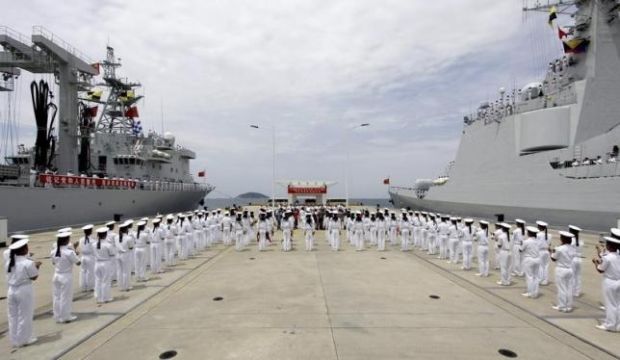
Chinese navy sailors stand in formation as they attend a send-off ceremony before departing for the Rim of the Pacific exercise (RIMPAC), at a military port in Sanya, Hainan province, China, on June 9, 2014. (Reuters/Stringer)
Beijing, Reuters—China outlined a strategy to boost its naval reach on Tuesday and held a groundbreaking ceremony for two lighthouses in disputed waters, developments likely to escalate tensions in a region already jittery about Beijing’s maritime ambitions.
In a policy document issued by the State Council, the Communist-ruled country’s cabinet, China vowed to increase its “open seas protection,” switching from air defense to both offense and defense, and criticized neighbors who take “provocative actions” on its reefs and islands.
China has been taking an increasingly assertive posture over recent years in the disputed waters of the South China Sea, where Beijing has engaged in land reclamation in the Spratly archipelago.
China, which claims most of the South China Sea, criticized Washington after a US spy plane flew over areas near the reefs last week, with both sides accusing each other of stoking instability.
It has overlapping claims with the Philippines, Vietnam, Malaysia, Taiwan and Brunei in the South China Sea, through which 5 trillion US dollars in ship-borne trade passes every year.
Defense Ministry spokesman Yang Yujun said China’s reclamation in the Spratlys was comparable with construction of homes and roads on the mainland.
“From the perspective of sovereignty, there is absolutely no difference,” he told reporters.
Some countries with “ulterior motives” had unfairly characterized China’s military presence and sensationalized the issue, he said. Surveillance in the region was increasingly common and China would continue to take “necessary measures” to respond.
“Some external countries are also busy meddling in South China Sea affairs. A tiny few maintain constant close-in air and sea surveillance and reconnaissance against China,” the strategy paper said in a thinly veiled reference to the United States.
It said China’s air force would shift its focus from territorial air defense to both offence and defense, and building airspace defenses with stronger military capabilities.
China also hosted a groundbreaking ceremony for the building of two lighthouses in the South China Sea, broadcast on state television, defying calls from the United States and the Philippines for a freeze on such activity.
The construction was to help maritime search and rescue, disaster relief, environmental protection and navigational security, Chinese Foreign Ministry spokeswoman Hua Chunying said.
Wu Shicun, president of the government-affiliated National Institute for South China Sea Studies, said the lighthouses were among the first of planned civilian-use facilities in the region.
“The reefs are located near an important commercial shipping route, so there will be continued development to maintain the security of those shipping lanes,” he said in an interview with Reuters.
The People’s Liberation Army’s nuclear force, known as the Second Artillery Corps, would also strengthen its capabilities for deterrence and nuclear counterattack as well as medium- and long-range precision strikes, the paper said.
“China faces many complex maritime security threats and challenges and requires a navy that can carry out multifaceted missions and protect its sovereignty,” Wang Jin, a senior colonel, told reporters.
The paper also cited “grave threats” to China’s cyber infrastructure, adding that China would hasten development of a cyber-military force.
Self-ruled Taiwan, which China considers a renegade province, called on all South China Sea claimants to shelve their disagreements to enable talks on sharing resources before a conflict breaks out.
Japan meanwhile will join a major US–Australian military exercise for the first time in a sign of growing security links between the three countries as tensions fester over China’s moves.
All three nations have said they are concerned about freedom of movement through the South China Sea and air space.
China’s Ministry of Defense said on Tuesday it had carried out military training for party cadres from border and coastal areas on border defense, among other topics.
The trainees, who visited military combat units, developed a better understanding of the “national security situation,” said a statement on the ministry’s website.
